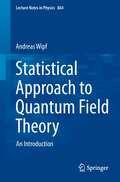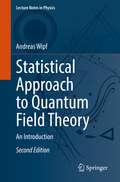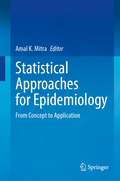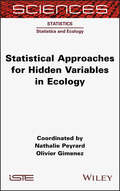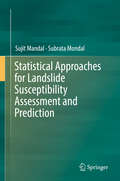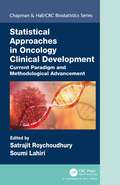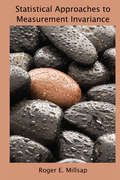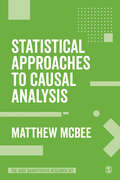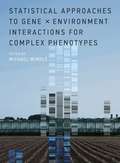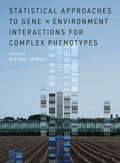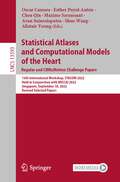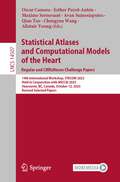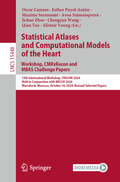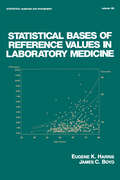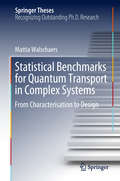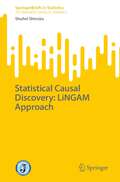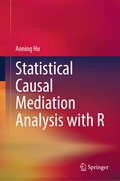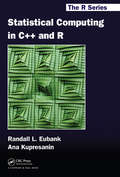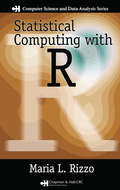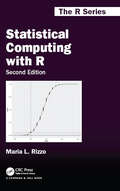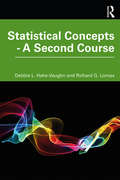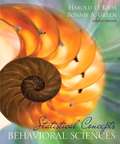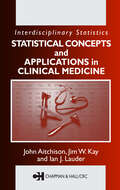- Table View
- List View
Statistical Approach to Quantum Field Theory
by Andreas WipfOver the past few decades the powerful methods of statistical physics and Euclidean quantum field theory have moved closer together, with common tools based on the use of path integrals. The interpretation of Euclidean field theories as particular systems of statistical physics has opened up new avenues for understanding strongly coupled quantum systems or quantum field theories at zero or finite temperatures. Accordingly, the first chapters of this book contain a self-contained introduction to path integrals in Euclidean quantum mechanics and statistical mechanics. The resulting high-dimensional integrals can be estimated with the help of Monte Carlo simulations based on Markov processes. The most commonly used algorithms are presented in detail so as to prepare the reader for the use of high-performance computers as an "experimental" tool for this burgeoning field of theoretical physics. Several chapters are then devoted to an introduction to simple lattice field theories and a variety of spin systems with discrete and continuous spins, where the ubiquitous Ising model serves as an ideal guide for introducing the fascinating area of phase transitions. As an alternative to the lattice formulation of quantum field theories, variants of the flexible renormalization group methods are discussed in detail. Since, according to our present-day knowledge, all fundamental interactions in nature are described by gauge theories, the remaining chapters of the book deal with gauge theories without and with matter. This text is based on course-tested notes for graduate students and, as such, its style is essentially pedagogical, requiring only some basics of mathematics, statistical physics, and quantum field theory. Yet it also contains some more sophisticated concepts which may be useful to researchers in the field. Each chapter ends with a number of problems - guiding the reader to a deeper understanding of some of the material presented in the main text - and, in most cases, also features some listings of short, useful computer programs.
Statistical Approach to Quantum Field Theory: An Introduction (Lecture Notes in Physics #992)
by Andreas WipfThis new expanded second edition has been totally revised and corrected. The reader finds two complete new chapters. One covers the exact solution of the finite temperature Schwinger model with periodic boundary conditions. This simple model supports instanton solutions – similarly as QCD – and allows for a detailed discussion of topological sectors in gauge theories, the anomaly-induced breaking of chiral symmetry and the intriguing role of fermionic zero modes. The other new chapter is devoted to interacting fermions at finite fermion density and finite temperature. Such low-dimensional models are used to describe long-energy properties of Dirac-type materials in condensed matter physics. The large-N solutions of the Gross-Neveu, Nambu-Jona-Lasinio and Thirring models are presented in great detail, where N denotes the number of fermion flavors. Towards the end of the book corrections to the large-N solution and simulation results of a finite number of fermion flavors are presented. Further problems are added at the end of each chapter in order to guide the reader to a deeper understanding of the presented topics. This book is meant for advanced students and young researchers who want to acquire the necessary tools and experience to produce research results in the statistical approach to Quantum Field Theory.
Statistical Approaches for Epidemiology: From Concept to Application
by Amal K. MitraThis textbook provides the basic concepts of epidemiology while preparing readers with the skills of applying statistical tools in real-life situations. Students, in general, struggle with statistical theories and their practical applications. This book makes statistical concepts easy to understand by focusing on real-life examples, case studies, and exercises. It also provides step-by-step guides for data analysis and interpretation using standard statistical software such as SPSS, SAS, R, Python, and GIS as appropriate, illustrating the concepts.Through the book's 23 chapters, readers primarily learn how to apply statistical methods in epidemiological studies and problem-solving. Among the topics covered:Clinical TrialsEpidemic Investigation and ControlGeospatial Applications in EpidemiologySurvival Analysis and Applications Using SAS and SPSSSystematic Review and Meta-Analysis: Evidence-based Decision-Making in Public HealthMissing Data Imputation: A Practical Guide Artificial Intelligence and Machine LearningMultivariate Linear Regression and Logistics Regression Analysis Using SASEach chapter is written by eminent scientists and experts worldwide, including contributors from institutions in the United States, Canada, Bangladesh, India, Hong Kong, Malaysia, and the Middle East. Statistical Approaches for Epidemiology: From Concept to Application is an all-in-one book that serves as an essential text for graduate students, faculty, instructors, and researchers in public health and other branches of health sciences, as well as a useful resource for health researchers in industry, public health and health department professionals, health practitioners, and health research organizations and non-governmental organizations. The book also will be helpful for graduate students and faculty in related disciplines such as data science, nursing, social work, environmental health, occupational health, computer science, statistics, and biology.
Statistical Approaches for Hidden Variables in Ecology
by Olivier Gimenez Nathalie PeyrardThe study of ecological systems is often impeded by components that escape perfect observation, such as the trajectories of moving animals or the status of plant seed banks. These hidden components can be efficiently handled with statistical modeling by using hidden variables, which are often called latent variables. Notably, the hidden variables framework enables us to model an underlying interaction structure between variables (including random effects in regression models) and perform data clustering, which are useful tools in the analysis of ecological data.This book provides an introduction to hidden variables in ecology, through recent works on statistical modeling as well as on estimation in models with latent variables. All models are illustrated with ecological examples involving different types of latent variables at different scales of organization, from individuals to ecosystems. Readers have access to the data and R codes to facilitate understanding of the model and to adapt inference tools to their own data.
Statistical Approaches for Landslide Susceptibility Assessment and Prediction
by Sujit Mandal Subrata MondalThis book focuses on the spatial distribution of landslide hazards of the Darjeeling Himalayas. Knowledge driven methods and statistical techniques such as frequency ratio model (FRM), information value model (IVM), logistic regression model (LRM), index overlay model (IOM), certainty factor model (CFM), analytical hierarchy process (AHP), artificial neural network model (ANN), and fuzzy logic have been adopted to identify landslide susceptibility. In addition, a comparison between various statistical models were made using success rate cure (SRC) and it was found that artificial neural network model (ANN), certainty factor model (CFM) and frequency ratio based fuzzy logic approach are the most reliable statistical techniques in the assessment and prediction of landslide susceptibility in the Darjeeling Himalayas. The study identified very high, high, moderate, low and very low landslide susceptibility locations to take site-specific management options as well as to ensure developmental activities in theDarjeeling Himalayas.Particular attention is given to the assessment of various geomorphic, geotectonic and geohydrologic attributes that help to understand the role of different factors and corresponding classes in landslides, to apply different models, and to monitor and predict landslides. The use of various statistical and physical models to estimate landslide susceptibility is also discussed. The causes, mechanisms and types of landslides and their destructive character are elaborated in the book. Researchers interested in applying statistical tools for hazard zonation purposes will find the book appealing.
Statistical Approaches in Oncology Clinical Development: Current Paradigm and Methodological Advancement (Chapman & Hall/CRC Biostatistics Series)
by Satrajit Roychoudhury Soumi LahiriStatistical Approaches in Oncology Clinical Development : Current Paradigm and Methodological Advancement presents an overview of statistical considerations in oncology clinical trials, both early and late phase of development. It illustrates how novel statistical methods can enrich the design and analysis of modern oncology trials. The authors include many relevant real life examples from the pharmaceutical industry and academia based on their first-hand experience. Along with relevant references, the book highlights current regulatory views. The book covers all aspects of cancer clinical trial starting from early phase development. The early part of the book covers novel phase I dose escalation design, exposure response analysis, and innovative phase II design. This includes early development strategy for cancer immunotherapy trials. The contributors also emphasized the role of biomarker and modern era of precision medicine. The second part focuses on the late stage development. This includes the application of adaptive design, safety analysis, and quality of life (QoL) data analysis. The final part discusses current regulatory perspective and challenges. Features: Covers a wide spectrum of topics related to real-life statistical challenges in oncology clinical trials. Provides a comprehensive overview of novel statistical methods to improve trial design and statistical analysis. Detailed case studies illustrate the real life applications. Satrajit Roychoudhury is a Senior Director and a member of the Statistical Research and Innovation group in Pfizer Inc. Prior to joining; he was a member of Statistical Methodology and consulting group in Novartis. He has 11 years of extensive experience in working with different phases of clinical trial. His area of research includes early phase oncology trials, survival analysis, model informed drug development, and use of Bayesian methods in clinical trials. He is industry co-chair for the ASA Biopharmaceutical Section Regulatory-Industry Workshop and has provided statistical training in major conferences including the Joint Statistical Meetings, ASA Biopharmaceutical Section Regulatory-Industry Workshop, and ICSA Applied Statistics Symposium. Soumi Lahiri has 12 years of extensive experience in working different therapeutic areas. She is the former Director of Biostatistics in Clinical Oncology, GlaxoSmithKline. She has also worked in the oncology division of Novartis Pharmaceutical Company for two years. She is an active member of the ASA Biopharmaceutical section and former chair of the membership committee.
Statistical Approaches to Measurement Invariance
by Roger E. MillsapThis book reviews the statistical procedures used to detect measurement bias. Measurement bias is examined from a general latent variable perspective so as to accommodate different forms of testing in a variety of contexts including cognitive or clinical variables, attitudes, personality dimensions, or emotional states. Measurement models that underlie psychometric practice are described, including their strengths and limitations. Practical strategies and examples for dealing with bias detection are provided throughout. The book begins with an introduction to the general topic, followed by a review of the measurement models used in psychometric theory. Emphasis is placed on latent variable models, with introductions to classical test theory, factor analysis, and item response theory, and the controversies associated with each, being provided. Measurement invariance and bias in the context of multiple populations is defined in chapter 3 followed by chapter 4 that describes the common factor model for continuous measures in multiple populations and its use in the investigation of factorial invariance. Identification problems in confirmatory factor analysis are examined along with estimation and fit evaluation and an example using WAIS-R data. The factor analysis model for discrete measures in multiple populations with an emphasis on the specification, identification, estimation, and fit evaluation issues is addressed in the next chapter. An MMPI item data example is provided. Chapter 6 reviews both dichotomous and polytomous item response scales emphasizing estimation methods and model fit evaluation. The use of models in item response theory in evaluating invariance across multiple populations is then described, including an example that uses data from a large-scale achievement test. Chapter 8 examines item bias evaluation methods that use observed scores to match individuals and provides an example that applies item response theory to data introduced earlier in the book. The book concludes with the implications of measurement bias for the use of tests in prediction in educational or employment settings. A valuable supplement for advanced courses on psychometrics, testing, measurement, assessment, latent variable modeling, and/or quantitative methods taught in departments of psychology and education, researchers faced with considering bias in measurement will also value this book.
Statistical Approaches to Causal Analysis (The SAGE Quantitative Research Kit)
by Matthew McBeeThis book provides an up-to-date and accessible introduction to causal inference in quantitative research. Featuring worked example datasets throughout, it clearly outlines the steps involved in carrying out various types of statistical causal analysis. In turn, helping you apply these methods to your own research. It contains guidance on: Selecting the most appropriate conditioning method for your data. Applying the Rubin’s Causal Model to your analysis, a mathematical framework for understanding and ensuring accurate causation inferences. Utilising various techniques and designs, such as propensity scores, instrumental variables analysis, and regression discontinuity designs, to better synthesise and analyse different types of data. Part of The SAGE Quantitative Research Kit, this book will give you the know-how and confidence needed to succeed on your quantitative research journey.
Statistical Approaches to Causal Analysis (The SAGE Quantitative Research Kit)
by Matthew McBeeThis book provides an up-to-date and accessible introduction to causal inference in quantitative research. Featuring worked example datasets throughout, it clearly outlines the steps involved in carrying out various types of statistical causal analysis. In turn, helping you apply these methods to your own research. It contains guidance on: Selecting the most appropriate conditioning method for your data. Applying the Rubin’s Causal Model to your analysis, a mathematical framework for understanding and ensuring accurate causation inferences. Utilising various techniques and designs, such as propensity scores, instrumental variables analysis, and regression discontinuity designs, to better synthesise and analyse different types of data. Part of The SAGE Quantitative Research Kit, this book will give you the know-how and confidence needed to succeed on your quantitative research journey.
Statistical Approaches to Gene x Environment Interactions for Complex Phenotypes
by Michael WindleFindings from the Human Genome Project and from Genome-Wide Association (GWA) studies indicate that many diseases and traits manifest a more complex genomic pattern than previously assumed. These findings, and advances in high-throughput sequencing, suggest that there are many sources of influence -- genetic, epigenetic, and environmental. This volume investigates the role of the interactions of genes and environment (G × E) in diseases and traits (referred to by the contributors as complex phenotypes) including depression, diabetes, obesity, and substance use. The contributors first present different statistical approaches or strategies to address G × E and G × G interactions with high-throughput sequenced data, including two-stage procedures to identify G × E and G × G interactions, marker-set approaches to assessing interactions at the gene level, and the use of a partial-least square (PLS) approach. The contributors then turn to specific complex phenotypes, research designs, or combined methods that may advance the study of G × E interactions, considering such topics as randomized clinical trials in obesity research, longitudinal research designs and statistical models, and the development of polygenic scores to investigate G × E interactions.ContributorsFatima Umber Ahmed, Yin-Hsiu Chen, James Y. Dai, Caroline Y. Doyle, Zihuai He, Li Hsu, Shuo Jiao, Erin Loraine Kinnally, Yi-An Ko, Charles Kooperberg, Seunggeun Lee, Arnab Maity, Jeanne M. McCaffery, Bhramar Mukherjee, Sung Kyun Park, Duncan C. Thomas, Alexandre Todorov, Jung-Ying Tzeng, Tao Wang, Michael Windle, Min Zhang
Statistical Approaches to Gene x Environment Interactions for Complex Phenotypes
by Michael WindleDiverse methodological and statistical approaches for investigating the role of gene-environment interactions in a range of complex diseases and traits. Findings from the Human Genome Project and from Genome-Wide Association (GWA) studies indicate that many diseases and traits manifest a more complex genomic pattern than previously assumed. These findings, and advances in high-throughput sequencing, suggest that there are many sources of influence—genetic, epigenetic, and environmental. This volume investigates the role of the interactions of genes and environment (G × E) in diseases and traits (referred to by the contributors as complex phenotypes) including depression, diabetes, obesity, and substance use. The contributors first present different statistical approaches or strategies to address G × E and G × G interactions with high-throughput sequenced data, including two-stage procedures to identify G × E and G × G interactions, marker-set approaches to assessing interactions at the gene level, and the use of a partial-least square (PLS) approach. The contributors then turn to specific complex phenotypes, research designs, or combined methods that may advance the study of G × E interactions, considering such topics as randomized clinical trials in obesity research, longitudinal research designs and statistical models, and the development of polygenic scores to investigate G × E interactions. Contributors Fatima Umber Ahmed, Yin-Hsiu Chen, James Y. Dai, Caroline Y. Doyle, Zihuai He, Li Hsu, Shuo Jiao, Erin Loraine Kinnally, Yi-An Ko, Charles Kooperberg, Seunggeun Lee, Arnab Maity, Jeanne M. McCaffery, Bhramar Mukherjee, Sung Kyun Park, Duncan C. Thomas, Alexandre Todorov, Jung-Ying Tzeng, Tao Wang, Michael Windle, Min Zhang
Statistical Atlases and Computational Models of the Heart. Regular and CMRxMotion Challenge Papers: 13th International Workshop, STACOM 2022, Held in Conjunction with MICCAI 2022, Singapore, September 18, 2022, Revised Selected Papers (Lecture Notes in Computer Science #13593)
by Shuo Wang Oscar Camara Maxime Sermesant Alistair Young Avan Suinesiaputra Chen Qin Esther Puyol-AntónThis book constitutes the proceedings of the 13th International Workshop on Statistical Atlases and Computational Models of the Heart, STACOM 2022, held in conjunction with the 25th MICCAI conference. The 34 regular workshop papers included in this volume were carefully reviewed and selected after being revised and deal with topics such as: common cardiac segmentation and modelling problems to more advanced generative modelling for ageing hearts, learning cardiac motion using biomechanical networks, physics-informed neural networks for left atrial appendage occlusion, biventricular mechanics for Tetralogy of Fallot, ventricular arrhythmia prediction by using graph convolutional network, and deeper analysis of racial and sex biases from machine learning-based cardiac segmentation. In addition, 14 papers from the CMRxMotion challenge are included in the proceedings which aim to assess the effects of respiratory motion on cardiac MRI (CMR) imaging quality and examine the robustness of segmentation models in face of respiratory motion artefacts. A total of 48 submissions to the workshop was received.
Statistical Atlases and Computational Models of the Heart. Regular and CMRxRecon Challenge Papers: 14th International Workshop, STACOM 2023, Held in Conjunction with MICCAI 2023, Vancouver, BC, Canada, October 12, 2023, Revised Selected Papers (Lecture Notes in Computer Science #14507)
by Oscar Camara Maxime Sermesant Alistair Young Avan Suinesiaputra Esther Puyol-Antón Qian Tao Chengyan WangThis book constitutes the proceedings of the 14th International Workshop on Statistical Atlases and Computational Models of the Heart, STACOM 2023, as well as the Cardiac MRI Reconstruction Challenge, CMRxRecon Challenge. There was a total of 53 submissions to the workshop. The 24 regular workshop papers included in this volume were carefully reviewed and selected from 29 paper submissions. They deal with cardiac segmentation, modelling, strain quantification, registration, statistical shape analysis, and quality control. In addition, 21 papers from the CMRxRecon challenge are included in this volume. They focus on fast CMR image reconstruction and provide a benchmark dataset that enables the broader research community to promote advances in this area of research.
Statistical Atlases and Computational Models of the Heart. Workshop, CMRxRecon and MBAS Challenge Papers.: 15th International Workshop, STACOM 2024, Held in Conjunction with MICCAI 2024, Marrakesh, Morocco, October 10, 2024, Revised Selected Papers (Lecture Notes in Computer Science #15448)
by Oscar Camara Maxime Sermesant Alistair Young Jichao Zhao Avan Suinesiaputra Esther Puyol-Antón Qian Tao Chengyan WangThis book constitutes the proceedings of the 15th International Workshop on Statistical Atlases and Computational Models of the Heart, STACOM 2024, held in conjunction with the 27th International conference on Medical Image Computing and Computer Assisted Intervention, MICCAI 2024, in Marrakesh, Morocco in October 2024. The 48 regular workshop papers included in this volume were carefully reviewed and selected from 64 paper submissions. They focus on Regular Papers; Multiclass Bi-Atrial Segmentation Challenge and Cardiac MRI Reconstruction Challenge.
Statistical Bases of Reference Values in Laboratory Medicine
by Eugene K. Harris James C. BoydExamining the strengths and limitations of various standards of accuracy in clinical laboratory analyses, this detailed reference presents an in-depth study of important theoretical and empirical issues concerning the description, collection, and application of reference values in laboratory medicine.
Statistical Benchmarks for Quantum Transport in Complex Systems: From Characterisation To Design (Springer Theses)
by Mattia WalschaersThis book introduces a variety of statistical tools for characterising and designing the dynamical features of complex quantum systems. These tools are applied in the contexts of energy transfer in photosynthesis, and boson sampling. In dynamical quantum systems, complexity typically manifests itself via the interference of a rapidly growing number of paths that connect the initial and final states. The book presents the language of graphs and networks, providing a useful framework to discuss such scenarios and explore the rich phenomenology of transport phenomena. As the complexity increases, deterministic approaches rapidly become intractable, which leaves statistics as a viable alternative.
Statistical Capacity Building
by Thomas K. Morrison Zia Abbasi Noel Atcherley Jaroslav Ku Era Graham L. SlackIMF technical assistance provided by the Statistics Department -- toward assisting IMF member countries in developing the ability to provide reliable and comparable economic and financial data on a timely basis to policymakers and markets -- has increased more than fourfold over the past decade. This assistance has proven critical in countries' building their statistical capacity so as to come into line with international data standards in an increasingly globalized and electronically interconnected world. Statistical Capacity Building: Case Studies and Lessons Learned presents four case studies drawn from experience in three countries in transition to the market, two of which were also in postconflict situations, in the 1990s and early 2000s: Cambodia, Bosnia and Herzegovina, and Ukraine. Issues of setting, institutional and statistical arrangements, strategies, and implementation are examined, and lessons drawn.
Statistical Causal Discovery: LiNGAM Approach (SpringerBriefs in Statistics)
by Shohei ShimizuThis is the first book to provide a comprehensive introduction to a new semiparametric causal discovery approach known as LiNGAM, with the fundamental background needed to understand it. It offers a general overview of the basics of the LiNGAM approach for causal discovery, estimation principles, and algorithms. This semiparametric approach is one of the most exciting new topics in the field of causal discovery. The new framework assumes parametric assumptions on the functional forms of structural equations but makes no assumption on the distributions of exogenous variables other than non-Gaussianity. It provides data-analysis tools capable of estimating a much wider class of causal relations even in the presence of hidden common causes. This feature is in contrast to conventional nonparametric approaches based on conditional independence of variables. This book is highly recommended to readers who seek an in-depth and up-to-date overview of this new causal discovery approach to advance the technique as well as to those who are interested in applying this approach to real-world problems. This LiNGAM approach should become a standard item in the toolbox of statisticians, machine learners, and practitioners who need to perform observational studies.
Statistical Causal Mediation Analysis with R
by Anning HuThis book comprehensively covers various causal mediation analysis (CMA) methods developed across multiple fields, organizing them into a reader-friendly progression of methodological advancements. Interest in the mechanisms that form causal relationships is widespread across various fields, including sociology, demography, economics, political science, psychology, epidemiology, public health, and educational studies, to name a few. Compared to the well-established research focusing on bivariate causality, CMA—the study of mediation mechanisms within the framework of causal inference—requires more complex identification assumptions, estimation methods, and nuanced interpretations of the results. Therefore, to conduct CMA with rigor, one must acquaint themselves with a distinct and systematic body of knowledge that is clearly separate from traditional linear regression modeling or structural equation modelling (SEM). Against this backdrop, the objectives of the proposed book are twofold. Firstly, it aims to offer readers an approachable and engaging explanation of the statistical theories underpinning the diverse methods of CMA. Specifically, we highlight the crucial mediation identification assumptions—a critical aspect frequently neglected by practitioners and educators. Secondly, the book intends to guide readers through detailed, step-by-step examples of applying CMA methods in practical research contexts. Through this approach, readers are anticipated to gain practical skills necessary for addressing their own research or teaching challenges. This book begins with traditional methods that rely on differences or products of coefficients in linear regression modeling, moves on to CMA involving a single mediator, and advances to more sophisticated approaches that manage parallel or sequentially ordered mediators. Additionally, sensitivity analysis is introduced as an important supplementary analytical step. Thus, the content spans from conventional CMA tools to the forefront methodologies that have emerged in recent decades. The book is designed to be self-sufficient, characterized by a balanced and well-integrated presentation of both theory and application.
Statistical Computing in C++ and R (Chapman & Hall/CRC The R Series)
by Randall L. Eubank Ana KupresaninParallel processing can be ideally suited for the solving of more complex problems in statistical computing. This book discusses code development in C++ and R, before going beyond to look at the valuable use of these two languages in unison. It covers linear equation solution with regression and linear models motivation, optimization with maximum likelihood and nonlinear least squares motivation, and random number generation. While the text does require a working knowledge of basic concepts in statistics and experience in programming, it does not require knowledge specific to C++ or R.
Statistical Computing with R (Chapman And Hall/crc The R Ser.)
by Maria L. RizzoComputational statistics and statistical computing are two areas that employ computational, graphical, and numerical approaches to solve statistical problems, making the versatile R language an ideal computing environment for these fields. One of the first books on these topics to feature R, Statistical Computing with R covers the traditiona
Statistical Computing with R, Second Edition (Chapman & Hall/CRC The R Series)
by Maria L. RizzoComputational statistics and statistical computing are two areas that employ computational, graphical, and numerical approaches to solve statistical problems, making the versatile R language an ideal computing environment for these fields. This second edition continues to encompass the traditional core material of computational statistics, with an
Statistical Concepts - A Second Course
by Richard G. Lomax Debbie L. Hahs-VaughnStatistical Concepts—A Second Course presents the last 10 chapters from An Introduction to Statistical Concepts, Fourth Edition. Designed for second and upper-level statistics courses, this book highlights how statistics work and how best to utilize them to aid students in the analysis of their own data and the interpretation of research results. In this new edition, Hahs-Vaughn and Lomax discuss sensitivity, specificity, false positive and false negative errors. Coverage of effect sizes has been expanded upon and more organizational features (to summarize key concepts) have been included. A final chapter on mediation and moderation has been added for a more complete presentation of regression models. This book acts as a clear and accessible instructional tool to help readers fully understand statistical concepts and how to apply them to data. It is an invaluable resource for students undertaking a course in statistics in any number of social science and behavioral science disciplines.
Statistical Concepts For The Behavioral Sciences
by Harold O. Kiess Bonnie A. GreenThis text emphasizes contemporary research problems to better illustrate the relevance of statistical analysis in scientific research. All statistical methods are introduced in the context of a realistic problem, many of which are from contemporary published research. Visit Bonnie and Hal's Statistical Sage Blog which includes helpful information on teaching and engaging students in your undergraduage statistics course! Click here:http://statisticalsage. wordpress. com/
Statistical Concepts and Applications in Clinical Medicine
by John Aitchison Jim W. Kay Ian J. LauderStatistical Concepts and Applications in Clinical Medicine presents a unique, problem-oriented approach to using statistical methods in clinical medical practice through each stage of the clinical process, including observation, diagnosis, and treatment. The authors present each consultative problem in its original form, then describe the process o
